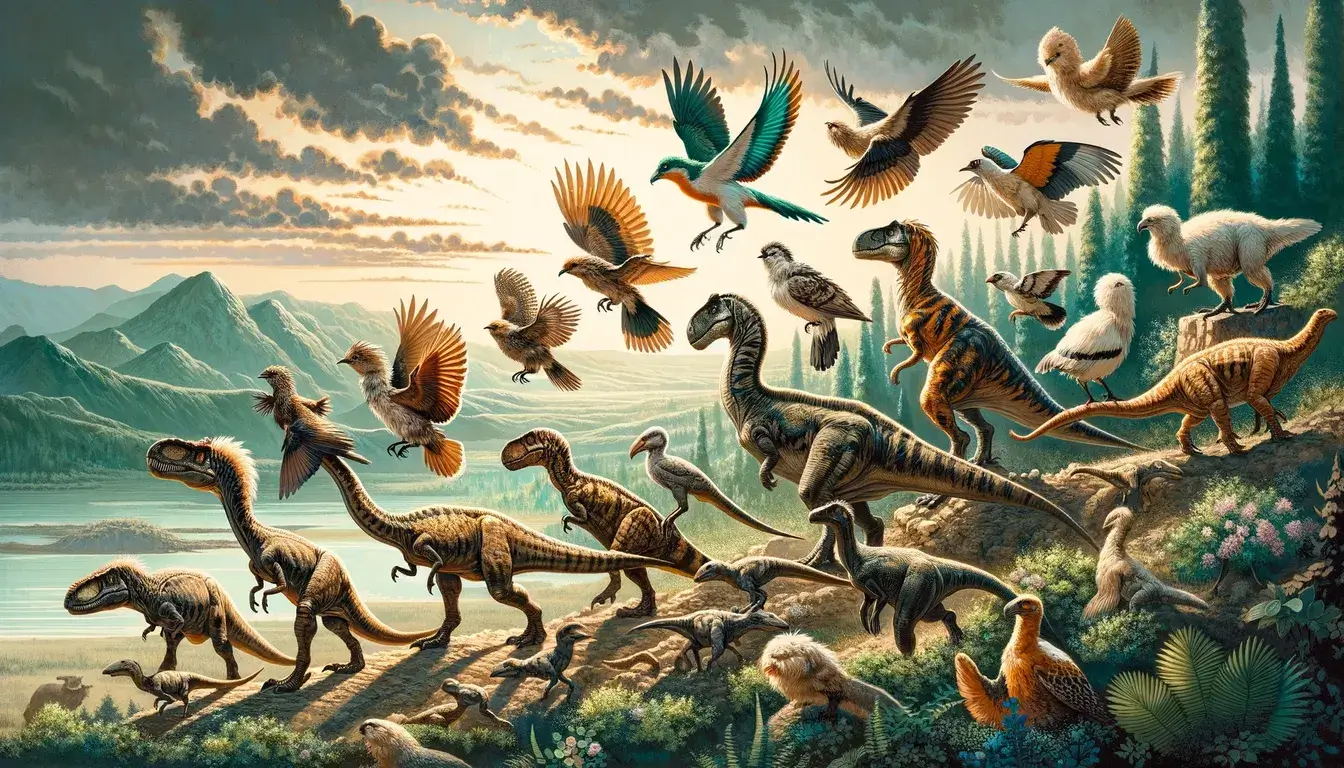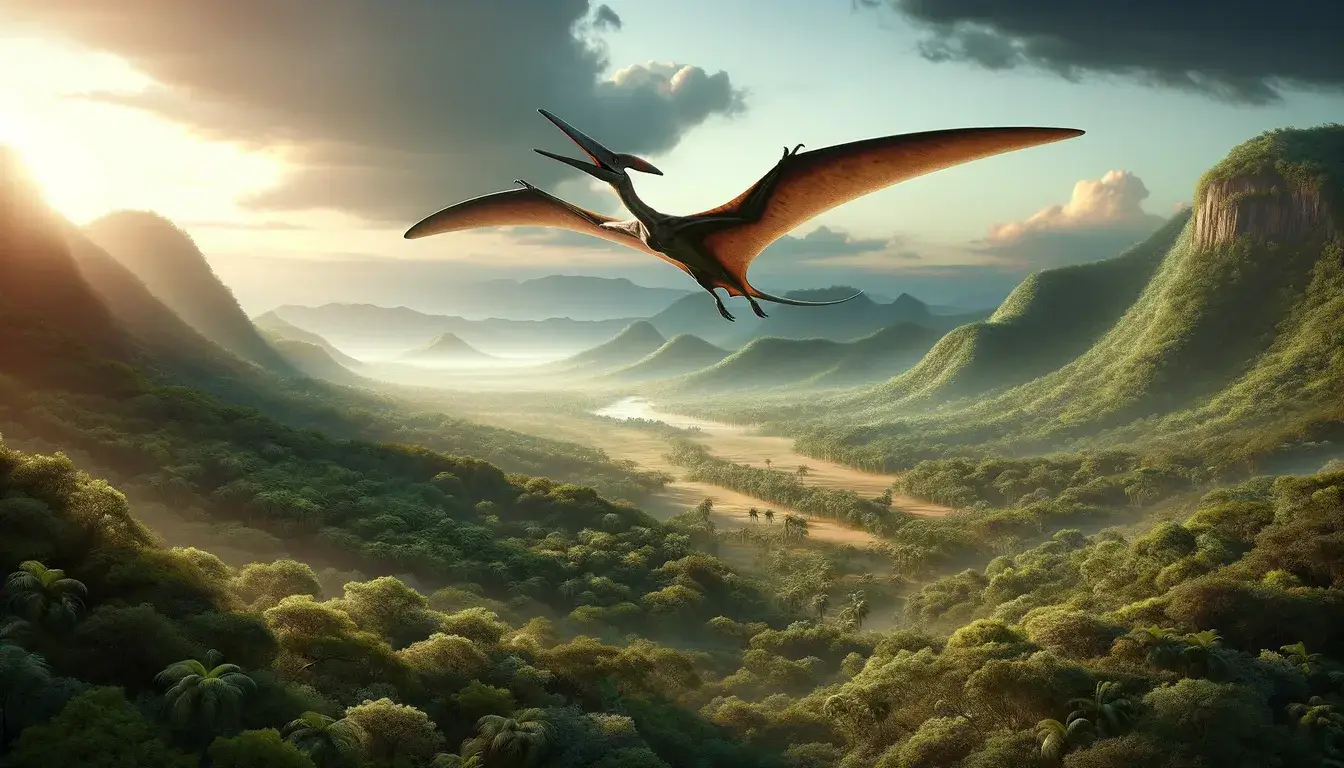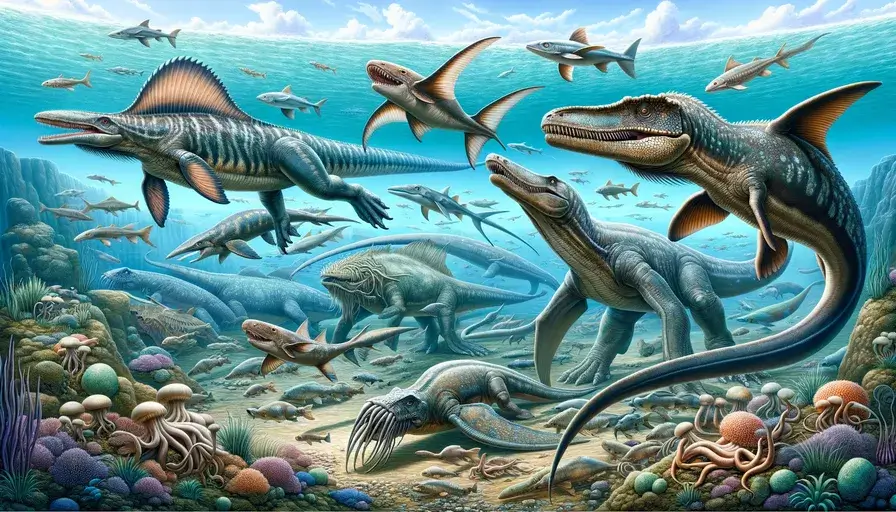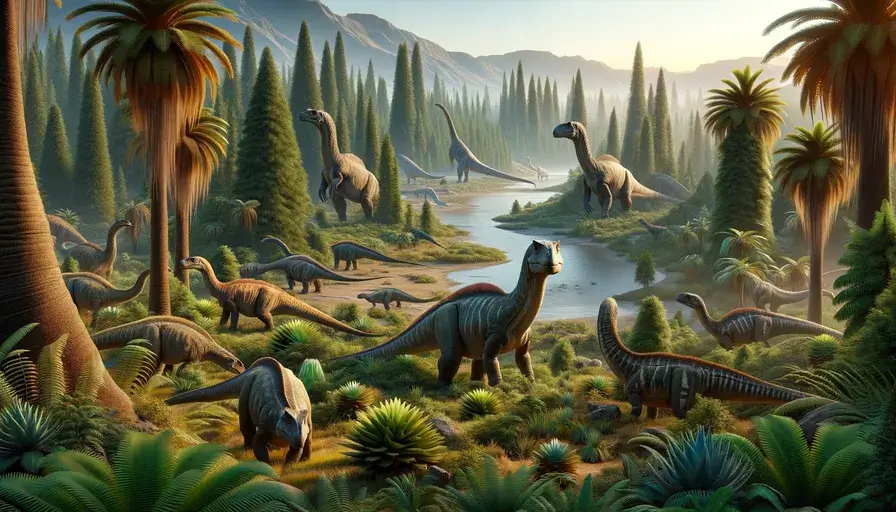Picture this: you’re standing in a lush, green landscape filled with towering trees and strange, exotic plants. In the distance, a herd of massive, long-necked sauropods graze peacefully, while a flock of winged reptiles soars overhead. Welcome to the Cretaceous Period, the last and longest chapter of the Age of Dinosaurs!
This may sound like a scene from a movie, but the Cretaceous Period was a very real and incredibly important time in Earth’s history. Spanning from 145 million to 66 million years ago, this 79-million-year slice of time saw the rise and fall of some of the most iconic dinosaurs, as well as profound changes in the planet’s geography and climate.
In this article, we’ll embark on a journey back in time to explore the wonders and mysteries of the Cretaceous Period. We’ll discover:
- The incredible creatures that roamed the Earth
- The dramatic shifts in landmasses and oceans
- The cataclysmic events that ultimately brought an end to the reign of the dinosaurs
So, let’s dig in and uncover the secrets of this fascinating era!
The Cretaceous Timeline: A Journey Through Time
To truly appreciate the scope and significance of the Cretaceous Period, it helps to have a visual representation of its major events and milestones. That’s where our interactive timeline comes in! Let’s take a closer look at some of the key moments that defined this incredible era:
| Time (Million Years Ago) | Event |
|---|---|
| 145 | The Cretaceous Period begins |
| 125 | The rise of flowering plants (angiosperms) |
| 100 | The appearance of iconic dinosaurs like Tyrannosaurus rex and Triceratops |
| 93 | The formation of a vast inland sea in North America |
| 83 | The evolution of early birds from small, feathered dinosaurs |
| 66 | The end-Cretaceous mass extinction event |
As you can see, the Cretaceous Period was a time of tremendous change and evolution. From the first appearance of flowers to the emergence of some of the most famous dinosaurs, this era was filled with momentous developments that would shape the course of life on Earth.
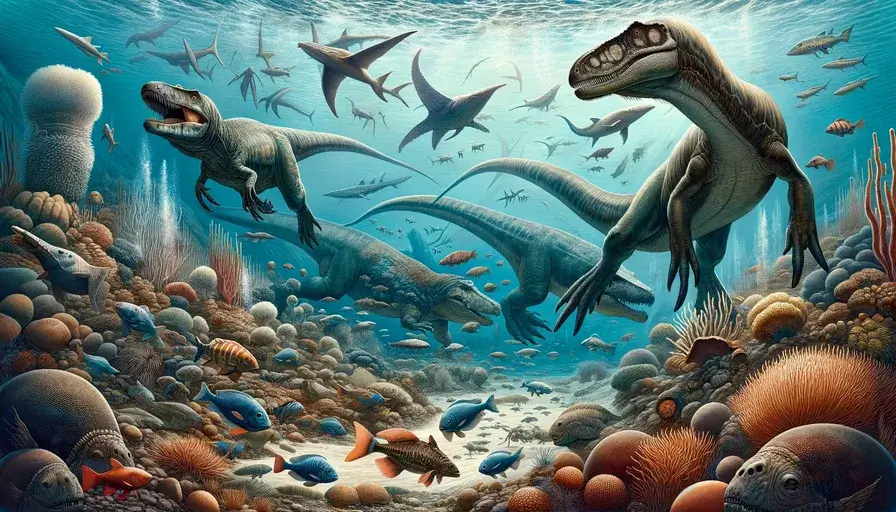
But the Cretaceous wasn’t just about the dinosaurs. This period also saw:
- The rise of early mammals
- The diversification of insects
- The evolution of modern groups of fish and marine reptiles
It was a time of incredible biodiversity and innovation in the natural world.
Of course, the Cretaceous Period is perhaps best known for its dramatic and mysterious conclusion. The end-Cretaceous mass extinction event, which wiped out the non-avian dinosaurs and many other groups of animals and plants, has captivated scientists and the public for generations. We’ll explore this fascinating topic in more detail later on.
A World in Flux: Geographical and Climatic Changes
One of the most striking aspects of the Cretaceous Period is the way in which the Earth’s geography and climate underwent profound transformations. Take a look at this animation to see how the continents shifted and rearranged themselves over the course of the era:
As you can see, the Cretaceous world looked very different from the one we know today. At the beginning of the period, the continents were clustered together in a supercontinent called Pangaea. But over time, Pangaea began to break apart, forming the continents and oceans we recognize now.
One of the most notable geographical features of the Cretaceous was the presence of a vast inland sea that covered much of what is now North America. This sea, known as the Western Interior Seaway, stretched from the Gulf of Mexico to the Arctic Ocean and was home to a diverse array of marine life, including:
- Giant marine reptiles like mosasaurs and plesiosaurs
- Huge bony fish
- Countless species of invertebrates
The Cretaceous also saw significant changes in the Earth’s climate. During the early part of the period, global temperatures were relatively warm, with little or no ice at the poles. This allowed for:
- The growth of lush forests
- The expansion of dinosaur habitats into polar regions
However, as the period progressed, the Earth’s climate began to cool and become more variable. By the end of the Cretaceous, global temperatures had dropped significantly, and the planet was experiencing a series of dramatic fluctuations between warm and cold periods.
These climatic changes had profound impacts on the distribution and evolution of life during the Cretaceous. As temperatures cooled and sea levels fell, many groups of animals and plants were forced to adapt to new conditions or face extinction. This process of adaptation and extinction would shape the course of life on Earth long after the Cretaceous had ended.
It’s incredible to think about how much the world changed during the Cretaceous Period. From the breakup of continents to the rise and fall of global temperatures, this era was a time of tremendous upheaval and transformation.
And yet, despite these challenges, life found a way to thrive and evolve, leaving behind a fascinating legacy that we’re still unraveling today.
The Cretaceous Menagerie: A World of Bizarre and Beautiful Creatures

When most people think of the Cretaceous Period, they immediately picture dinosaurs. And for good reason! This era was home to some of the most iconic and awe-inspiring dinosaurs that ever lived. From the towering Tyrannosaurus rex to the heavily armored Ankylosaurus, the Cretaceous was a time of incredible diversity among these fascinating creatures.
But dinosaurs were just one part of the amazingly varied ecosystem of the Cretaceous. This period also saw:
- The rise of flowering plants, which revolutionized terrestrial ecosystems
- The evolution of countless new species of insects, mammals, and birds
In the oceans, too, life was thriving:
- Marine reptiles like mosasaurs and plesiosaurs ruled the seas
- Huge bony fish and sharks patrolled the depths
- The skies were filled with pterosaurs, the flying reptiles that included some of the largest animals ever to take to the air
To give you a sense of the incredible creatures that called the Cretaceous home, here are just a few examples:
Tyrannosaurus rex
This massive predator was one of the last and largest of the non-avian dinosaurs. With its powerful jaws and teeth, T. rex was a formidable hunter that likely preyed on other dinosaurs.
Triceratops
This iconic dinosaur was a large, herbivorous creature known for its three horns and bony frill. Triceratops was one of the last dinosaurs to evolve before the end-Cretaceous extinction.
Mosasaurus
This giant marine reptile was a fearsome predator of the Cretaceous oceans. With its long, powerful jaws and flexible body, Mosasaurus was well-adapted for hunting fish, squid, and even other marine reptiles.
Quetzalcoatlus
This huge pterosaur was one of the largest flying animals of all time, with a wingspan of up to 36 feet (11 meters). Quetzalcoatlus likely fed on fish, reptiles, and even small dinosaurs.
These are just a few examples of the incredible diversity of life that existed during the Cretaceous Period. From the tiniest insects to the largest dinosaurs, this was a time of unparalleled innovation and adaptation in the natural world.
Dinosaur of the Week: Velociraptor

No discussion of Cretaceous dinosaurs would be complete without mentioning Velociraptor. Thanks to movies like Jurassic Park, this small, agile predator has become one of the most famous dinosaurs of all time. But how much do you really know about this fascinating creature?
Here are a few fun facts about Velociraptor:
- Despite its fearsome reputation, Velociraptor was actually quite small, about the size of a large turkey.
- Velociraptor had a large, sickle-shaped claw on each foot, which it likely used to slash at its prey.
- Fossil evidence suggests that Velociraptor was a pack hunter, working together with other members of its species to bring down larger prey.
- Velociraptor was covered in feathers, which may have been used for display or insulation.
So the next time you watch Jurassic Park, remember that the real Velociraptor was a bit different from its Hollywood counterpart!
Survival of the Fittest: Adaptations and Ecosystems in the Cretaceous
The incredible diversity of life in the Cretaceous Period was made possible by the endless variety of adaptations and ecological niches that these organisms evolved to fill. From the towering sauropods that browsed on the leaves of tall trees to the tiny mammals that scurried underfoot, each species had its own unique set of adaptations that allowed it to thrive in its environment.
One of the most important concepts in understanding Cretaceous ecosystems is the idea of food webs. A food web is a complex network of feeding relationships between different species in an ecosystem. In the Cretaceous, as in modern times, these webs were incredibly intricate, with each species playing a vital role in the flow of energy and nutrients through the system.
At the base of the Cretaceous food web were the primary producers, mainly plants and algae that used photosynthesis to convert sunlight into energy. These producers were consumed by a wide variety of herbivores, from tiny insects to massive sauropods. In turn, these herbivores were preyed upon by an array of carnivores, from small theropod dinosaurs to giant marine reptiles.
One of the key factors that allowed so many different species to coexist in the Cretaceous was niche partitioning. This refers to the way in which different species evolve to occupy distinct ecological roles, minimizing direct competition for resources. For example:
- Different species of herbivorous dinosaurs might have specialized in eating different types of plants
- Carnivorous dinosaurs might have hunted at different times of day or targeted different prey species
Another important aspect of Cretaceous ecology was the ongoing evolutionary arms race between predators and prey. As prey species evolved new defenses, such as armor, speed, or camouflage, predators had to evolve new strategies for catching them. This constant back-and-forth drove the evolution of ever more specialized and efficient adaptations on both sides.
Throughout the Cretaceous, these ecological processes played out on a grand scale, driving the evolution of an incredibly diverse and complex web of life. From the depths of the oceans to the heights of the skies, the Cretaceous was a time of unparalleled innovation and adaptation in the natural world.
The End of an Era: The Cretaceous-Paleogene Extinction Event

As we’ve seen, the Cretaceous Period was a time of incredible diversity and innovation in the natural world. But it was also a time of great upheaval and catastrophe, culminating in one of the most famous and mysterious events in Earth’s history: the end-Cretaceous mass extinction.
Also known as the Cretaceous-Paleogene (K-Pg) extinction, this event occurred approximately 66 million years ago and resulted in the sudden disappearance of an estimated 75% of all plant and animal species on Earth, including:
- All non-avian dinosaurs
- Pterosaurs
- Marine reptiles
- Many other groups
For many years, scientists have debated the cause of this catastrophic event. The leading theory is that it was triggered by the impact of a massive asteroid or comet, which struck the Earth near the present-day Yucatan Peninsula in Mexico. This impact, known as the Chicxulub impact after the crater it left behind, would have released an incredible amount of energy, equivalent to millions of nuclear bombs.
The immediate effects of the Chicxulub impact would have been devastating:
- The blast would have triggered massive tsunamis, earthquakes, and wildfires
- Vast amounts of debris would have been ejected into the atmosphere, darkening the skies for months or even years and disrupting photosynthesis on a global scale
- Over the longer term, the impact would also have released huge amounts of greenhouse gases, leading to rapid global warming
- The loss of so many plant species would have disrupted food chains and ecosystems around the world, leading to further extinctions
While the Chicxulub impact is now widely accepted as the primary cause of the end-Cretaceous extinction, some scientists believe that other factors may also have played a role. For example, there is evidence that massive volcanic eruptions in present-day India, known as the Deccan Traps, were also occurring around the same time. These eruptions could have released huge amounts of greenhouse gases and toxic chemicals, further stressing already fragile ecosystems.
Ultimately, the end-Cretaceous extinction was probably caused by a “perfect storm” of multiple catastrophic events, occurring in a relatively short period of time. The result was a world forever changed, in which the dominant lifeforms of the previous 180 million years were suddenly and irreversibly wiped out.
The end-Cretaceous extinction was a pivotal moment in Earth’s history, marking the end of one era and the beginning of another. It reminds us of the incredible power of natural forces to shape the course of life on our planet, and of the fragility of even the most successful and enduring species.
Conclusion: The Legacy of the Cretaceous
The Cretaceous Period may have ended in catastrophe, but its legacy endures to this day. The innovations and adaptations that evolved during this time helped to shape the course of life on Earth, paving the way for the rise of mammals, birds, and flowering plants in the ensuing Cenozoic Era. Today, we can see the echoes of the Cretaceous in the incredible diversity of life around us, from the songs of birds to the flowers in our gardens. As we continue to study this fascinating period in Earth’s history, we gain a deeper appreciation for the complex and ever-changing nature of life on our planet.

